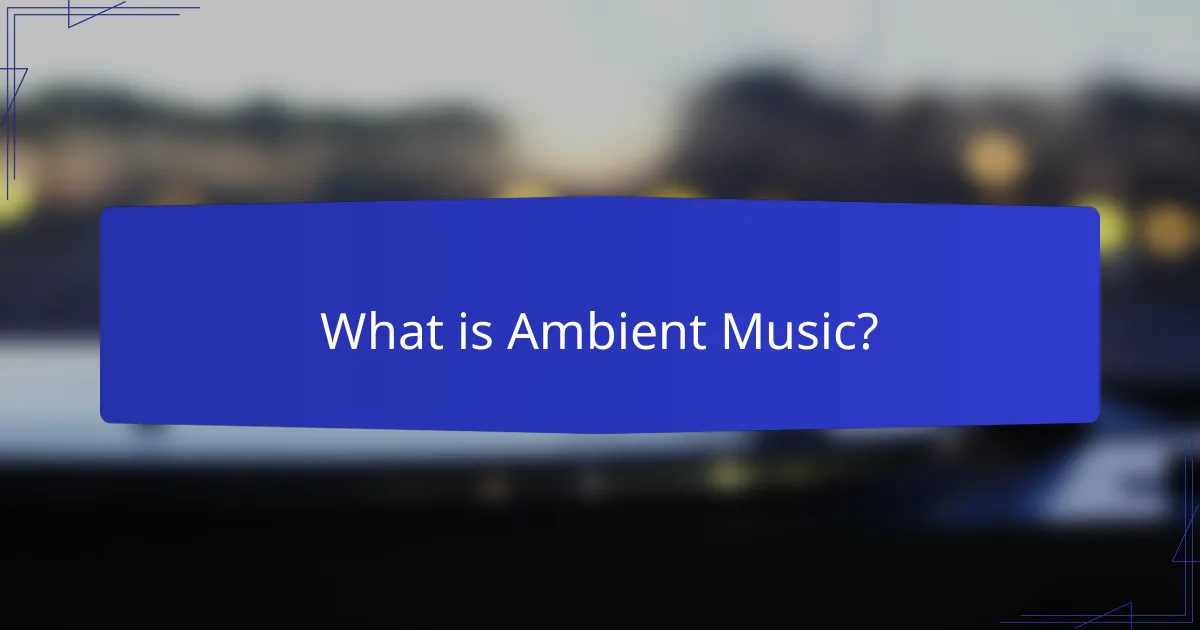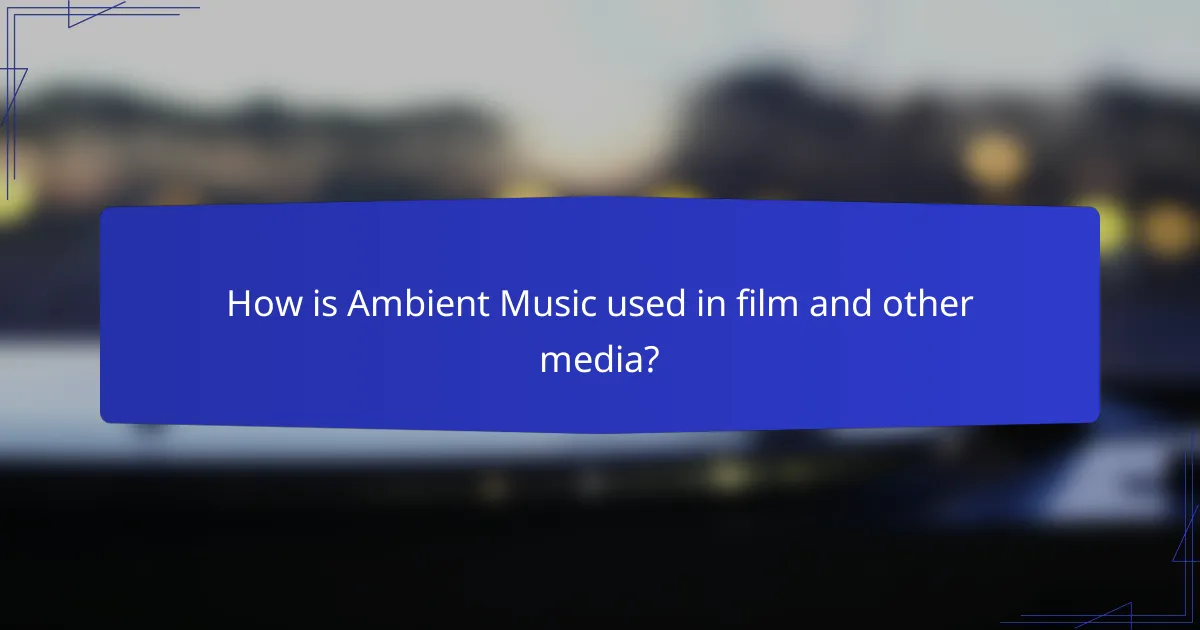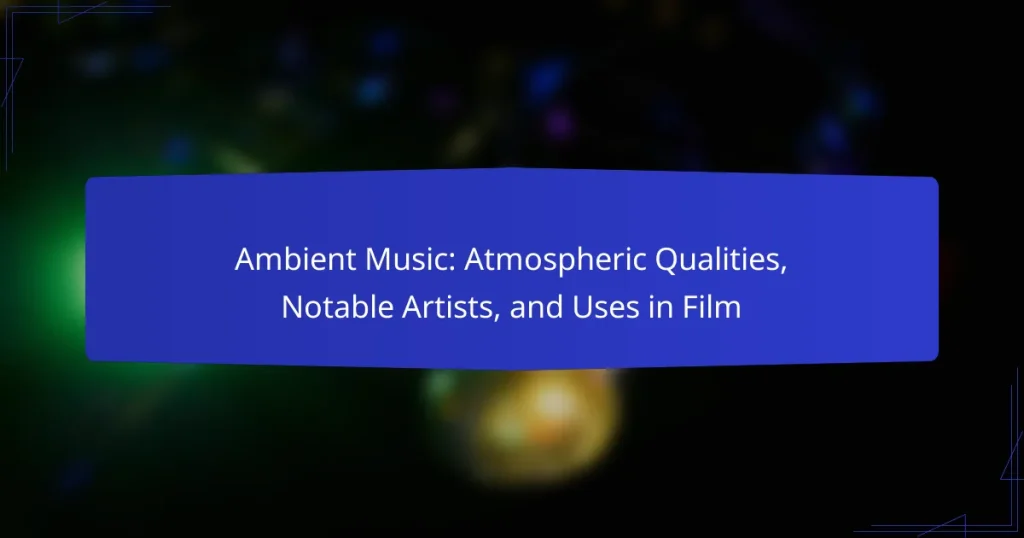Ambient music is a genre characterized by its emphasis on tone and atmosphere rather than traditional musical structures. This genre often incorporates soft sounds, minimal rhythms, and elements such as natural sounds and electronic textures to create immersive soundscapes. Notable artists like Brian Eno, Aphex Twin, and Steve Roach have significantly shaped the genre, with Eno’s “Music for Airports” being a landmark album. Ambient music is widely utilized in film and media to enhance emotional depth and atmosphere, seamlessly integrating with visual elements to influence audience perception and engagement.

What is Ambient Music?
Ambient music is a genre that emphasizes tone and atmosphere over traditional musical structure. It often features soft, flowing sounds and minimal rhythmic elements. This type of music is designed to create a mood or evoke a specific environment. Ambient music can often include natural sounds, electronic textures, and instrumental layers. It is frequently used in film and media to enhance emotional depth. Notable artists in this genre include Brian Eno and Aphex Twin. Brian Eno’s album “Music for Airports” is a landmark in ambient music history. The genre’s focus on soundscapes makes it distinct from more conventional music forms.
How is Ambient Music defined in the music genre spectrum?
Ambient music is defined as a genre that emphasizes tone and atmosphere over traditional musical structure. It often features long, sustained sounds and minimalistic compositions. This genre is designed to create an immersive auditory experience. Ambient music can evoke feelings of calmness and introspection. It often lacks a clear rhythm or beat, which differentiates it from other genres. The genre emerged in the 1970s, popularized by artists like Brian Eno. Eno’s album “Ambient 1: Music for Airports” is a significant example of the genre’s characteristics. Ambient music is frequently used in film and video games to enhance emotional depth. It serves as a backdrop that supports visual storytelling without overwhelming it.
What are the key characteristics that distinguish Ambient Music?
Ambient music is characterized by its focus on atmosphere and tone over traditional musical structure. It often features slow, evolving soundscapes that create a sense of space. The use of non-intrusive melodies is common, allowing the listener to experience the music as a background. Ambient music typically includes electronic instruments and field recordings for texture. Its compositions are often lengthy, encouraging deep listening and immersion. Artists like Brian Eno have significantly shaped the genre, emphasizing its meditative qualities. The genre is used in various contexts, including film, to evoke specific moods and enhance storytelling.
How does Ambient Music differ from other music genres?
Ambient music is characterized by its focus on atmosphere and texture rather than traditional musical structure. Unlike genres such as rock or pop, ambient music often lacks a clear rhythm or melody. This genre emphasizes soundscapes that create a mood or environment. Ambient music is typically instrumental and can include natural sounds or synthesized tones. It is designed to be immersive and can evoke emotional responses without the need for lyrics. Artists like Brian Eno pioneered this genre, emphasizing its distinct purpose of enhancing the listening environment. This contrasts with other genres that prioritize lyrical content or rhythmic complexity. Ambient music’s unique attribute lies in its ability to serve as a background for relaxation or contemplation.
What are the historical origins of Ambient Music?
Ambient music originated in the 1970s as a genre that emphasizes atmosphere over traditional musical structure. Pioneering artists like Brian Eno played a significant role in defining this style. Eno’s album “Ambient 1: Music for Airports,” released in 1978, is often cited as a foundational work. The genre draws influences from minimalism, electronic music, and experimental sounds. It aims to create immersive soundscapes that enhance the listener’s environment. Ambient music often incorporates natural sounds and synthesizers to evoke emotion and tranquility. Its roots can be traced back to earlier avant-garde movements and the works of composers like Erik Satie. The genre has evolved over the decades, influencing various forms of media, including film soundtracks.
Who were the pioneers of Ambient Music?
The pioneers of Ambient Music include Brian Eno, John Cage, and Tangerine Dream. Brian Eno is often credited with defining the genre. His 1975 album “Ambient 1: Music for Airports” is a landmark work. John Cage’s experimental compositions laid the groundwork for ambient concepts. His use of silence and chance in music influenced many ambient artists. Tangerine Dream contributed with their electronic soundscapes in the 1970s. Their album “Phaedra” is a significant release in the genre. These artists shaped the development of ambient music through innovation and exploration.
How has Ambient Music evolved over the decades?
Ambient music has evolved significantly since its inception in the 1970s. Initially, it emerged as a genre focused on creating atmospheric soundscapes. Pioneers like Brian Eno defined ambient music with works such as “Music for Airports” in 1978. This album introduced the concept of music as an environment rather than a traditional composition.
In the 1980s, ambient music began to incorporate elements from electronic and new age genres. Artists like Klaus Schulze and Tangerine Dream expanded the use of synthesizers and sequencers. The 1990s saw a rise in subgenres, including ambient house and chillout music, influenced by the rave culture.
By the 2000s, ambient music diversified further with the integration of field recordings and minimalism. Artists such as Stars of the Lid and A Winged Victory for the Sullen explored drone-based compositions. The advent of digital technology also allowed for easier production and distribution, broadening the audience.
Today, ambient music influences various genres and continues to be used in film and media for its atmospheric qualities. Its evolution reflects changes in technology, culture, and artistic expression throughout the decades.
What are the atmospheric qualities of Ambient Music?
Ambient music is characterized by its atmospheric qualities, which create immersive soundscapes. These qualities include a focus on tone and timbre over traditional musical structure. Ambient music often utilizes extended durations and minimalistic compositions. The sound is typically layered, creating depth and texture. It frequently incorporates natural sounds and field recordings. This genre is designed to evoke a sense of space and environment. Artists like Brian Eno have pioneered these atmospheric elements. Studies show that ambient music can reduce stress and enhance relaxation.
How do soundscapes contribute to the ambiance of the music?
Soundscapes enhance the ambiance of music by creating immersive auditory environments. They provide contextual layers that influence listeners’ emotional responses. For instance, natural sounds like rain or wind can evoke feelings of tranquility. Conversely, urban soundscapes may generate a sense of chaos or energy. Research shows that soundscapes can alter perception of time and space in music. Studies indicate that listeners often report deeper engagement with music when soundscapes are present. This interplay between soundscapes and music enriches the overall listening experience.
What role do textures and timbres play in creating atmosphere?
Textures and timbres are essential in creating atmosphere in ambient music. Textures refer to the layers of sound that build complexity. They can evoke emotions and set a mood. Timbres describe the unique quality of each sound. Different timbres can suggest various environments or feelings. For example, a warm, soft timbre may create a calming atmosphere. In contrast, sharp or harsh timbres can evoke tension or unease. Research shows that the combination of diverse textures and timbres enhances listener engagement. This is crucial in ambient music, where atmosphere is a primary focus. Thus, textures and timbres significantly shape the listener’s experience and emotional response.

Who are the notable artists in Ambient Music?
Notable artists in Ambient Music include Brian Eno, Aphex Twin, and Steve Roach. Brian Eno is often credited with pioneering the genre. His album “Music for Airports” is a seminal work in ambient music. Aphex Twin, known for his innovative soundscapes, has significantly influenced electronic music. Steve Roach is recognized for his long-form compositions that create immersive environments. Other notable artists include Tim Hecker and William Basinski, both of whom explore texture and atmosphere in their work. Each artist contributes unique elements to the ambient genre, shaping its evolution and expanding its reach.
What are some influential Ambient Music artists and their contributions?
Brian Eno is a pivotal figure in ambient music. He coined the term “ambient music” in the 1970s. His album “Music for Airports” is a landmark release. This work emphasizes sound as a backdrop rather than a focal point. Eno’s techniques influenced countless artists across genres.
Aphex Twin, known for his innovative soundscapes, contributed significantly to the genre. His album “Selected Ambient Works 85-92” blends ambient with electronic elements. This fusion has inspired many contemporary musicians.
Tangerine Dream, a German electronic music group, played a crucial role in developing ambient music. Their use of synthesizers created immersive sound environments. Albums like “Phaedra” exemplify their impact on the genre.
La Monte Young is another influential artist. He is known for his minimalist compositions that explore sustained tones. His work laid the groundwork for ambient music’s explorative nature.
These artists collectively shaped ambient music’s evolution and broadened its appeal. Their contributions continue to resonate in modern soundscapes.
How did Brian Eno shape the genre of Ambient Music?
Brian Eno significantly shaped the genre of Ambient Music through his innovative approach and conceptual frameworks. He coined the term “ambient music” with his 1978 album “Ambient 1: Music for Airports.” This album emphasized sound environments over traditional musical structures. Eno’s work promoted the idea of music as a background that enhances the atmosphere rather than demanding attention. He utilized tape loops, synthesizers, and natural sounds to create immersive soundscapes. Eno’s influence extends to various artists and genres, establishing Ambient Music as a legitimate artistic form. His techniques and philosophies have been foundational in the development of modern ambient and electronic music.
What impact did artists like Aphex Twin and Moby have on the genre?
Aphex Twin and Moby significantly influenced the ambient music genre. Aphex Twin introduced complex rhythms and innovative sound design. His album “Selected Ambient Works 85-92” showcased a blend of ambient and electronic elements. This work expanded the boundaries of what ambient music could encompass. Moby’s “Ambient” album emphasized melodic structures within ambient soundscapes. His music often incorporated elements of [censured] and introspection. Both artists brought mainstream attention to ambient music. Their contributions helped shape the genre’s evolution in the 1990s and beyond.
What are some key albums or tracks to explore in Ambient Music?
Key albums and tracks to explore in Ambient Music include “Music for Airports” by Brian Eno. Released in 1978, it is often considered a pioneering work in the genre. Another essential album is “Selected Ambient Works 85-92” by Aphex Twin. This collection features innovative soundscapes that have influenced many artists. “Ambient 1: Music for Airports” is notable for its serene qualities. “The Disintegration Loops” by William Basinski showcases the beauty of decay in sound. “Structures from Silence” by Steve Roach is also significant for its immersive textures. These albums exemplify the atmospheric qualities that define Ambient Music.
Which albums are considered seminal in the Ambient genre?
Seminal albums in the Ambient genre include “Ambient 1: Music for Airports” by Brian Eno. Released in 1978, it is often credited with establishing the ambient music genre. Another influential album is “Selected Ambient Works 85-92” by Aphex Twin, which showcases innovative soundscapes. “Music for 18 Musicians” by Steve Reich is also significant, blending minimalist techniques with ambient elements. “The Pearl,” a collaboration between Eno and Harold Budd, is recognized for its serene atmosphere. These albums have shaped the genre and influenced countless artists. Their impact is evident in the evolution of ambient music over the decades.
What are the standout tracks that define Ambient Music?
Standout tracks that define Ambient Music include “Music for Airports” by Brian Eno. This track is pivotal in creating an atmospheric soundscape. Another significant piece is “Weightless” by Marconi Union. It has been scientifically proven to reduce anxiety and promote relaxation. “A Rainbow in Curved Air” by Terry Riley is also essential, showcasing the blend of minimalism and improvisation. “The Pearl” by Harold Budd and Brian Eno exemplifies the serene qualities of ambient sound. Each of these tracks has influenced the genre and is recognized for its unique contribution to the ambient music landscape.

How is Ambient Music used in film and other media?
Ambient music is used in film and other media to create atmosphere and evoke emotions. It serves as a backdrop that enhances the visual experience without overwhelming it. Ambient music often features slow tempos and minimalistic structures. This allows it to blend seamlessly with dialogue and sound effects. It can heighten tension or provide relief in critical scenes. Films like “Blade Runner” and “The Tree of Life” exemplify its effective use. In video games, ambient music sets the mood and immerses players in the environment. Overall, ambient music plays a crucial role in storytelling by influencing audience perception and emotional engagement.
What role does Ambient Music play in enhancing film narratives?
Ambient music enhances film narratives by creating emotional depth and atmosphere. It sets the mood, guiding audience reactions to scenes. This genre often utilizes soundscapes to evoke feelings without intrusive melodies. By doing so, it allows viewers to immerse themselves in the story. Studies show that ambient music can influence viewer perception and engagement. For instance, a film’s tension can be heightened through subtle ambient sounds. This technique is evident in films like “Blade Runner,” where ambient music complements the visual aesthetics. Overall, ambient music plays a crucial role in shaping the cinematic experience.
How do filmmakers use Ambient Music to create mood and atmosphere?
Filmmakers use ambient music to create mood and atmosphere by enhancing emotional resonance and setting the tone of scenes. Ambient music often features soft, subtle sounds that evoke specific feelings without overwhelming dialogue or action. By manipulating volume and texture, filmmakers can create a sense of tension or tranquility. For example, low-frequency drones can evoke unease, while gentle harmonies can instill calmness. The use of ambient soundscapes also immerses viewers in the film’s world, making settings feel more realistic. Studies show that music significantly influences audience perception, impacting their emotional responses to visual content. Thus, ambient music is a crucial tool for filmmakers in shaping viewer experience.
What are some examples of films that effectively utilize Ambient Music?
Some examples of films that effectively utilize ambient music include “Blade Runner,” “The Revenant,” and “Arrival.” “Blade Runner,” directed by Ridley Scott, features a score by Vangelis that enhances its futuristic atmosphere. “The Revenant,” directed by Alejandro González Iñárritu, uses ambient soundscapes to immerse viewers in the wilderness. “Arrival,” directed by Denis Villeneuve, incorporates ambient music by Jóhann Jóhannsson to evoke emotional depth and tension. Each of these films demonstrates how ambient music can enhance storytelling and create a unique atmosphere.
What are the benefits of incorporating Ambient Music in various contexts?
Incorporating ambient music in various contexts enhances mood and promotes relaxation. Studies show that ambient music can reduce stress levels. This effect is particularly evident in workplace environments. Employees exposed to ambient music report increased focus and productivity. Ambient music also aids in creating immersive experiences in film and art. It can evoke emotions and set the tone for narratives. Research indicates that ambient soundscapes improve cognitive performance during tasks. Additionally, ambient music is beneficial in therapeutic settings, aiding in mental health recovery.
How does Ambient Music aid in relaxation and concentration?
Ambient music aids in relaxation and concentration by creating a soothing sound environment. It often features gentle melodies and minimalistic arrangements. This type of music can lower heart rates and reduce stress levels. Research indicates that ambient sounds can enhance focus during tasks. A study published in the Journal of Music Therapy found that participants performed better in concentration tasks while listening to ambient music. The calming effect of ambient music can lead to improved cognitive performance. By masking distracting noises, it helps maintain a peaceful atmosphere. Overall, ambient music serves as an effective tool for enhancing mental clarity and relaxation.
What are the therapeutic uses of Ambient Music in wellness practices?
Ambient music is utilized in wellness practices for its calming and restorative effects. It aids in reducing stress and anxiety levels. Research indicates that listening to ambient music can lower cortisol levels, a stress hormone. This genre promotes relaxation and enhances meditation experiences. Studies show that ambient music can improve focus during mindfulness exercises. It also fosters a sense of tranquility in therapeutic environments. Additionally, ambient music is used in sound therapy to facilitate emotional release. Overall, its therapeutic uses are well-documented and widely applied in various wellness settings.
What tips can help in selecting Ambient Music for different purposes?
Select ambient music based on its intended purpose. For relaxation, choose soothing sounds with slow tempos. For concentration, opt for tracks with minimal variation and repetitive patterns. If enhancing creativity, select music that evokes emotion without distraction. For meditation, look for music with natural elements and gentle harmonies. Consider the length of the track; longer pieces can provide an immersive experience. Pay attention to the overall mood; ensure it aligns with the desired atmosphere. Finally, explore different artists and genres to find unique sounds that resonate with your specific needs.
How can one choose the right Ambient Music for a specific setting?
To choose the right ambient music for a specific setting, consider the mood and atmosphere you want to create. Identify the emotional tone desired, such as calmness or energy. Analyze the characteristics of the space, including size and acoustics. Select music that complements these attributes. Research shows that ambient music can enhance focus and relaxation. For example, studies indicate that certain frequencies promote a tranquil environment. Additionally, consider the duration of the music to match the length of the activity in the setting. Ensure the volume level is appropriate for the space to avoid distraction.
What are some common mistakes to avoid when using Ambient Music?
Common mistakes to avoid when using ambient music include selecting inappropriate tracks. Choosing music that is too energetic can disrupt the intended atmosphere. Another mistake is neglecting volume levels. Ambient music should be in the background, not overpowering other sounds. Additionally, failing to match the music to the setting can lead to a disjointed experience. It’s important to consider the emotional tone of the space. Overusing the same track can also diminish its effectiveness. Variety keeps the ambiance fresh and engaging. Lastly, ignoring the audience’s preferences can result in a lack of connection. Understanding the audience enhances the overall impact of the ambient music.
Ambient music is a genre that prioritizes tone and atmosphere, characterized by soft sounds and minimal rhythmic elements, often used to enhance emotional depth in film and media. The article explores the historical origins of ambient music, its key characteristics, and notable artists such as Brian Eno and Aphex Twin, who have shaped the genre. Additionally, it discusses the atmospheric qualities of ambient music, its therapeutic uses, and how it contributes to storytelling in film. The article also provides tips for selecting appropriate ambient music for various settings, emphasizing its role in promoting relaxation and concentration.


